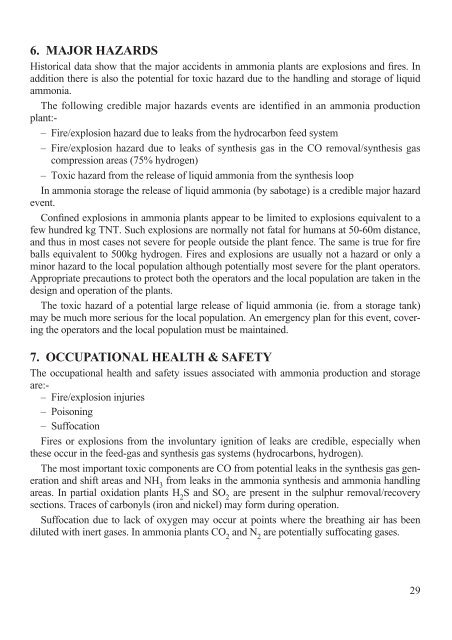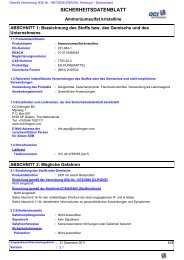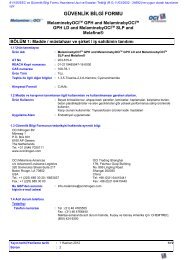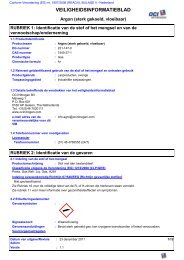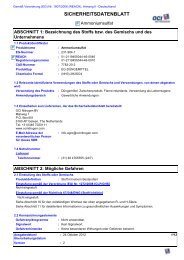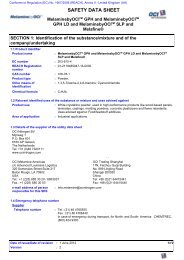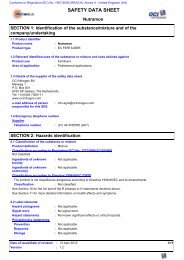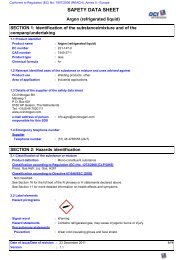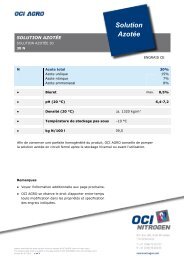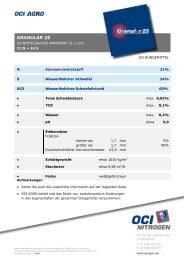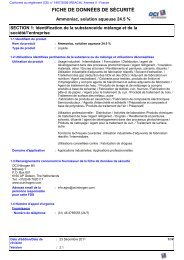PRODUCTION OF AMMONIA - OCI Nitrogen
PRODUCTION OF AMMONIA - OCI Nitrogen
PRODUCTION OF AMMONIA - OCI Nitrogen
Create successful ePaper yourself
Turn your PDF publications into a flip-book with our unique Google optimized e-Paper software.
6. MAJOR HAZARDS<br />
Historical data show that the major accidents in ammonia plants are explosions and fires. In<br />
addition there is also the potential for toxic hazard due to the handling and storage of liquid<br />
ammonia.<br />
The following credible major hazards events are identified in an ammonia production<br />
plant:-<br />
– Fire/explosion hazard due to leaks from the hydrocarbon feed system<br />
– Fire/explosion hazard due to leaks of synthesis gas in the CO removal/synthesis gas<br />
compression areas (75% hydrogen)<br />
– Toxic hazard from the release of liquid ammonia from the synthesis loop<br />
In ammonia storage the release of liquid ammonia (by sabotage) is a credible major hazard<br />
event.<br />
Confined explosions in ammonia plants appear to be limited to explosions equivalent to a<br />
few hundred kg TNT. Such explosions are normally not fatal for humans at 50-60m distance,<br />
and thus in most cases not severe for people outside the plant fence. The same is true for fire<br />
balls equivalent to 500kg hydrogen. Fires and explosions are usually not a hazard or only a<br />
minor hazard to the local population although potentially most severe for the plant operators.<br />
Appropriate precautions to protect both the operators and the local population are taken in the<br />
design and operation of the plants.<br />
The toxic hazard of a potential large release of liquid ammonia (ie. from a storage tank)<br />
may be much more serious for the local population. An emergency plan for this event, covering<br />
the operators and the local population must be maintained.<br />
7. OCCUPATIONAL HEALTH & SAFETY<br />
The occupational health and safety issues associated with ammonia production and storage<br />
are:-<br />
– Fire/explosion injuries<br />
– Poisoning<br />
– Suffocation<br />
Fires or explosions from the involuntary ignition of leaks are credible, especially when<br />
these occur in the feed-gas and synthesis gas systems (hydrocarbons, hydrogen).<br />
The most important toxic components are CO from potential leaks in the synthesis gas generation<br />
and shift areas and NH 3 from leaks in the ammonia synthesis and ammonia handling<br />
areas. In partial oxidation plants H 2 S and SO 2 are present in the sulphur removal/recovery<br />
sections. Traces of carbonyls (iron and nickel) may form during operation.<br />
Suffocation due to lack of oxygen may occur at points where the breathing air has been<br />
diluted with inert gases. In ammonia plants CO 2 and N 2 are potentially suffocating gases.<br />
29


